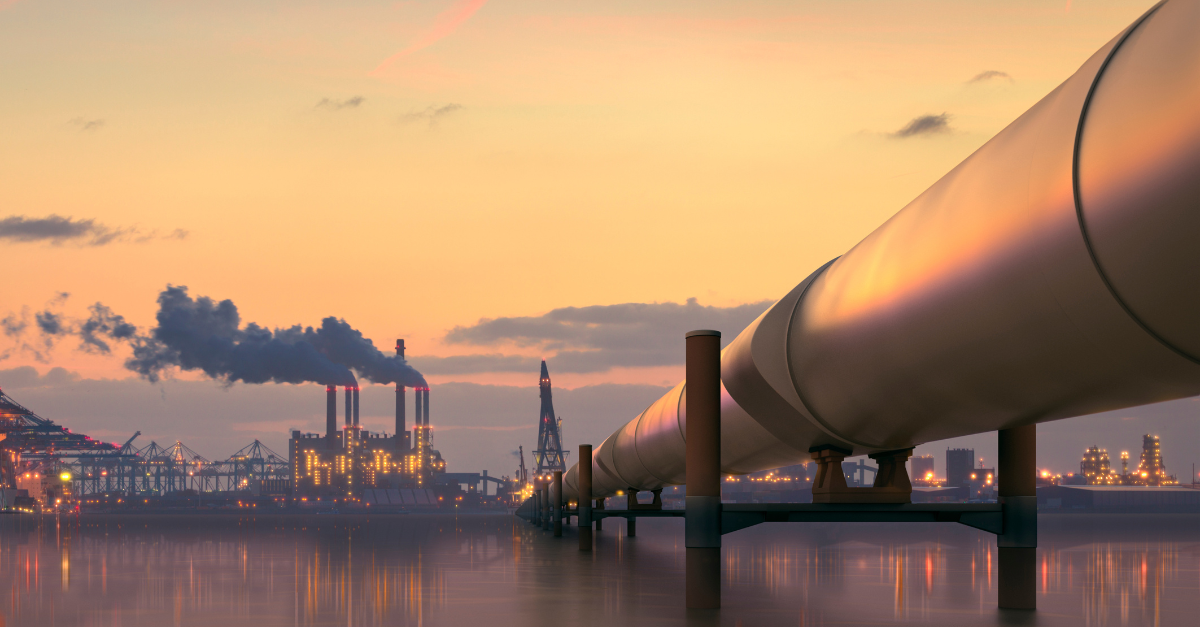When it comes to insulating LNG pipe, polyisocyanurate (PIR) and cellular glass are the two most commonly used materials. Both types are excellent insulation options when they are part of a well-designed, properly installed system. However, PIR’s many benefits can make it a preferred choice as it is cost effective and easier to work with.
While PIR and cellular glass are very different, both are successfully used in LNG applications and have long service lives. Cellular glass is exactly what it sounds like – glass, an inorganic material, that contains a myriad of closed cells. PIR is an organic material that is blown to create a foam, also containing closed cells. While both products are insulating materials, they differ in many of their properties.
The main advantages of cellular glass as LNG pipe insulation are its water resistance (zero permeability), its low flammability and a broader service temperature range. And since cellular glass is made entirely of closed glass cells, it offers very good resistance to both liquid water and water vapor infiltration.
The operating temperature range of cellular glass is -450°F to 900°F, whereas PIR is rated for -450°F to 300°F. Being inorganic, cellular glass is non-combustible, whereas Johns Manville’s PIR product Trymer® 2500 has an ASTM E84 rating of 25/295 (25/50 option available). The accessory products used with cellular glass, including joint sealants and vapor retarders, are organic. This means that the completed cellular glass insulation system does not have the same combustibility performance as the cellular glass insulation alone.
The biggest advantages of PIR insulation are its lower (better) thermal conductivity, lower density resulting in lower total system weight, ease of fabrication and its significantly lower total installed cost. When compared to cellular glass, PIR has a thermal conductivity that is 35-75% lower (and therefore superior). This difference in thermal conductivity directly translates into less insulation thickness needed when using PIR to prevent condensation control and/or limit the heat gain.
This means that PIR insulation systems have a smaller outer circumference than cellular glass systems by approximately 10-20%. As a result, PIR systems need less of the expensive accessory products like vapor retarders, joint sealant, and metal jacketing than cellular glass systems. As an example, a 6” NPS -260F° LNG line with 90F° ambient temperature, 85% relative humidity and 0 mph wind speed with jacketing emittance of 0.9 needs 5.5” thickness of Trymer PIR to prevent condensation. With the same calculations, changing the insulation to cellular glass will require 7” to prevent condensation.
Additionally, the total system using PIR insulation can cost less than cellular glass and has lower installation costs. PIR is easier to fabricate and install, while cellular glass is fragile and requires more expertise for installation. While some manufacturers might offer 3-foot segment lengths for cellular glass, the standard is 2-feet. Standard length for PIR is 3 feet for pipe shells/segments, which means there are 50% fewer circumferential joints. Fewer joints when installing PIR results in a faster installation, reducing the opportunity for water or water vapor to enter the system during construction/installation.
The main disadvantage of PIR is that while it is closed cell, it is not as water resistant as cellular glass. However, any concern with the water and water vapor resistance of PIR is eliminated by properly designing and installing the full insulation system, which is required for both PIR and cellular glass. A full insulation system includes dual vapor retarders, fully sealed joints between insulation pieces, vapor stops at key locations, and a properly installed outer protective jacket system.
At JM, we know there is no single best pipe insulation material; every material has advantages and disadvantages. When selecting an insulation material, specifiers should weigh the advantages and disadvantages against their relative importance for the specific project along with the history of successful use of the material in similar applications.
Overall, PIR insulation systems make a strong case for themselves. They require less insulation thickness, use less accessory material, and are easier to fabricate and install. As a result, the total installed cost savings of using PIR over cellular glass can be substantial.
Visit our page Insulation for Cryogenic and LNG Systems for additional resources, and check out our newly revised systems guide for PIR in LNG applications.
| Products | |
| Membrane Roofing Systems TPO PVC EPDM SBS APP BUR Liquid Applied | Roofing Components Insulation and Cover Boards Adhesives, Cements and Primers Specialty Roofing Products Fasteners and Plates Coatings |
For Professionals
Building Owners
Building Owner Resources
Preferred Accounts
Guarantees and Roof Maintenance
Find a Contractor
Contractors
Contractor Resources
JM Peak Advantage Contractor Program
Technical, Guarantee & Warranty Services
Peak Advantage Contractor Portal Login
Find a Distributor
Design Professionals
Design Professional Services
Specification and Design Assistance Request
BURSI Continuing Education Program
Nonwovens
Fiberglass Mat for:
Bituminous Roofing
Roof Decks
Roofing Shingles
Carpet Tiles
Ceiling Tiles
LVT Flooring
Resilient Flooring
Polyester Nonwoven for:
Bituminous Roofing
Carpet Tiles
Filtration Products
Air Filtration
HVAC
HEPA/ULPA
Air Pollution Control
Industrial Filtration
Liquid Filtration
Coolant Oil
Industrial Filtration
Reinforcement Fiberglass
Chopped Fiberglass for:
Polyamides (PA)
Polyolefins (PP, PE)
Gypsum Boards
Single-End Roving for:
Long Fiber Thermoplastics (LFT, D-LFT)
Structural Thermoplastics
Thermoset Composites
Multi-End Roving for:
Sheet Moulding Compound
Thermoset Composites

